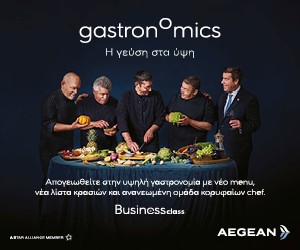Did you, until now, also believe that oysters, fondue and raclette could never be served in canteens? Or that good wine and fine ingredients aren`t compatible with street food? What a cliché! Here come the French to break this stereotype. And where, you might ask? In a multicultural yet off-Broadway spot in Kerameikos, just a few streets down from Pireos and steps away from Iera Odos—an area once associated with mainstream nightclubs and "dirty" canteens. Today, this multicultural neighbourhood houses alternative cafés, bars, and student hangouts in its previously half-derelict detached houses, while its shops have been transformed into Chinese clothing stores.
Of course, the neighbourhood`s scene has transformed dramatically over the last year. The change began on Kerameikos Street, where Alexandros Tsiotinis, along with Kostas Baroutis and Christos Rigas of CTC, opened Ortsag, a venue they described as a zero-waste street-food store.
A few months later, The Athens Street Hub started operating just a few blocks away. It is located in a different kind of "courtyard" with an industrial aesthetic reminiscent of English or American box parks, with container canteens surrounded by tables, benches, and garden chairs. There was already a bar (The Bar) and, at least for now from what I hear, the Four Hands by Giorgos Papazacharias and Thanos Feskos. This "courtyard" ofter hosts parties with guest DJs and occasionally features bars or canteens from abroad.
So, this is the Hub chosen as the location for the bar à vins by the French team I mentioned earlier. First, let me introduce the most renowned among them, Dominique Perrot—a chef with an impressive background. He began his career as the executive chef at the Elysée during the years of François Mitterrand`s presidency. In Greece, we first met him when he took on the role of executive chef at the then-newly opened Meridien Hotel. Later, we followed his culinary journey through various restaurants, from the one on the Delphon pedestrian street in Kolonaki to the Acropolis Museum`s restaurant, which he managed alongside the Elysée, his pastry shop, and catering service in Agios Dimitrios. More recently, he has been involved in the Pie Shop in Chalandri and on Voulis Street, where he introduced us with pies from the four corners of the world.
The second Frenchman, Florentin Le Noxaïc, is easily recognised by his white chef`s uniform, adorned with the insignia of the Tricolore (the French flag) at the height of the collar, as well as his baker`s cap, which he likely never takes off. A young entrepreneur from Lorient, Brittany, his role at La Cave is multifaceted; he serves guests, acts as a sommelier, and primarily manages imports from France. He carefully selects cheeses from small producers—not just for the raclette and fondue savoyarde featured on the menu, but also for the cheeses served on their planches. Additionally, he brings cured meats, caviar from Ferme de Neuvic, and, of course, oysters from Brittany.
The third partner, his Greek-French friend Alex Sparacello, was absent at the time, so Florentin took on the role of our guide through the flavours of his homeland. That evening, he played ball solo—not literally, although their shared love of rugby is what connected the two friends and led them to the Hub.
We naturally started with the oysters. I should mention that I was accompanied by my colleague and friend, Dino Stergidis, an expert on French delicacies, along with a mutual friend and collaborator. This allowed us to enjoy a dozen oysters in just a few minutes. They had received Fines de Claire - Cancale (no 3) from Brittany that morning, which are known for their firm texture and aromatic notes of hazelnut and iodine. We also tried the exceptional Krsytale oysters (no 3), farmed in Grainville, Normandy, using a unique hanging method that gives them a sweeter taste and richer flesh. Florentin suggested that we pair them with a glass of wine that would complement the oysters and indicated which accompaniments to choose based on salinity and type.
The breeze carried aromas of fresh bread and melting cheeses. We ordered a cheese and a charcuterie platter, from which I picked out an excellent jambon noir de Bigorre. Shortly after, Dominique Perrot brought us a cheese and mushroom omelette, which we shared straight from the pan, continuing with the wine that already accompanied our charcuterie and cheeses.
I took a moment to look around. The dozens of French wines at La Cave, nestled in the brightly lit container, resembled little soldiers standing at attention. I watched the crowd gather after shops closed, and the volume of the music began to rise. Outside, the street was now empty, devoid of the day`s commercial bustle, silent, dark. Only the light that illuminated a massive red graffiti piece created a surreal contrast. The entire scene made me feel that La Cave`s arrival at Athens Steet Hub might change our perception of canteen food, as it introduces different habits and raises the bar for street food to a higher level of quality and taste. It offers a fresh perspective—or perhaps serves as a French counter-proposal to the prevalence of greasy sandwiches and burgers.
Perhaps I was simply delighted to revisit that sense of sharing à la française and the spirit of relaxation that embodies French convivialité—the intimacy between friends. It reminded me of how the French approach their food: their ability to enjoy iconic products in a more casual setting, whether sharing shellfish at beachside cantinas or savouring cheeses and charcuterie at the comptoirs or bars à vin in the quaint villages of their country.
Info: Athens Street Hub Kerameikos 111, Kerameikos tel: 697 029 2444, https://lacave.my.canva.site/. Open: Thursday and Friday: 14:00-23:30, Saturday and Sunday 10:00-23:30.
















Login or register to join the conversation